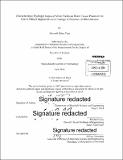Characterizing hydrogel imposed strain fields on brain tissue phantom for use in neural implant device coatings in presence of micromotion
Author(s)
Plaut, Maxwell Ethan
DownloadFull printable version (4.200Mb)
Other Contributors
Massachusetts Institute of Technology. Department of Materials Science and Engineering.
Advisor
Michael Cima.
Terms of use
Metadata
Show full item recordAbstract
Glial scar tissue forms in the brain as a response to the implant injury and hampers the effectiveness of the implant treatment. Constant relative micromotion between the mechanically mismatched neural implant and brain tissue is thought to play a key role glial scar formation. This study investigated the effects of poly(ethylene glycol) (PEG) hydrogel coatings for glass brain implant devices on strain fields imposed by those devices to brain tissue due to micromotion in the brain. PEG hydrogels were created using macromers of 2000-8000 Mw and 5-20 wt.% in solution. The moduli of the hydrogels were calculated via Hertzian analysis of force-deflection curves produced using an AFM tip as a nanoindenter. The moduli of the samples did not change significantly with change in macromer Mw, but did change with solution concentration. 20% gels had moduli of 120-180 kPa and 5-10% gels had moduli of 0-20 kPa. The strains imposed by the coated devices were found to be lower at the surface by ~30% as compared to uncoated and the strain field dropped off much more quickly.
Description
Thesis: S.B., Massachusetts Institute of Technology, Department of Materials Science and Engineering, 2014. Cataloged from PDF version of thesis. Includes bibliographical references (pages 27-30).
Date issued
2014Department
Massachusetts Institute of Technology. Department of Materials Science and EngineeringPublisher
Massachusetts Institute of Technology
Keywords
Materials Science and Engineering.